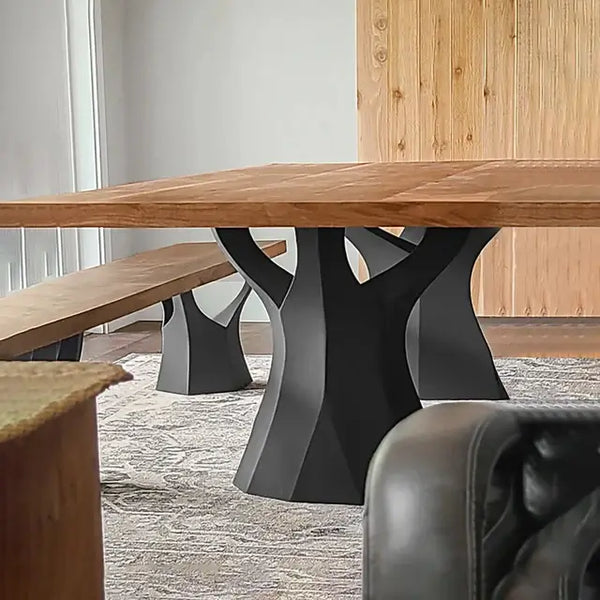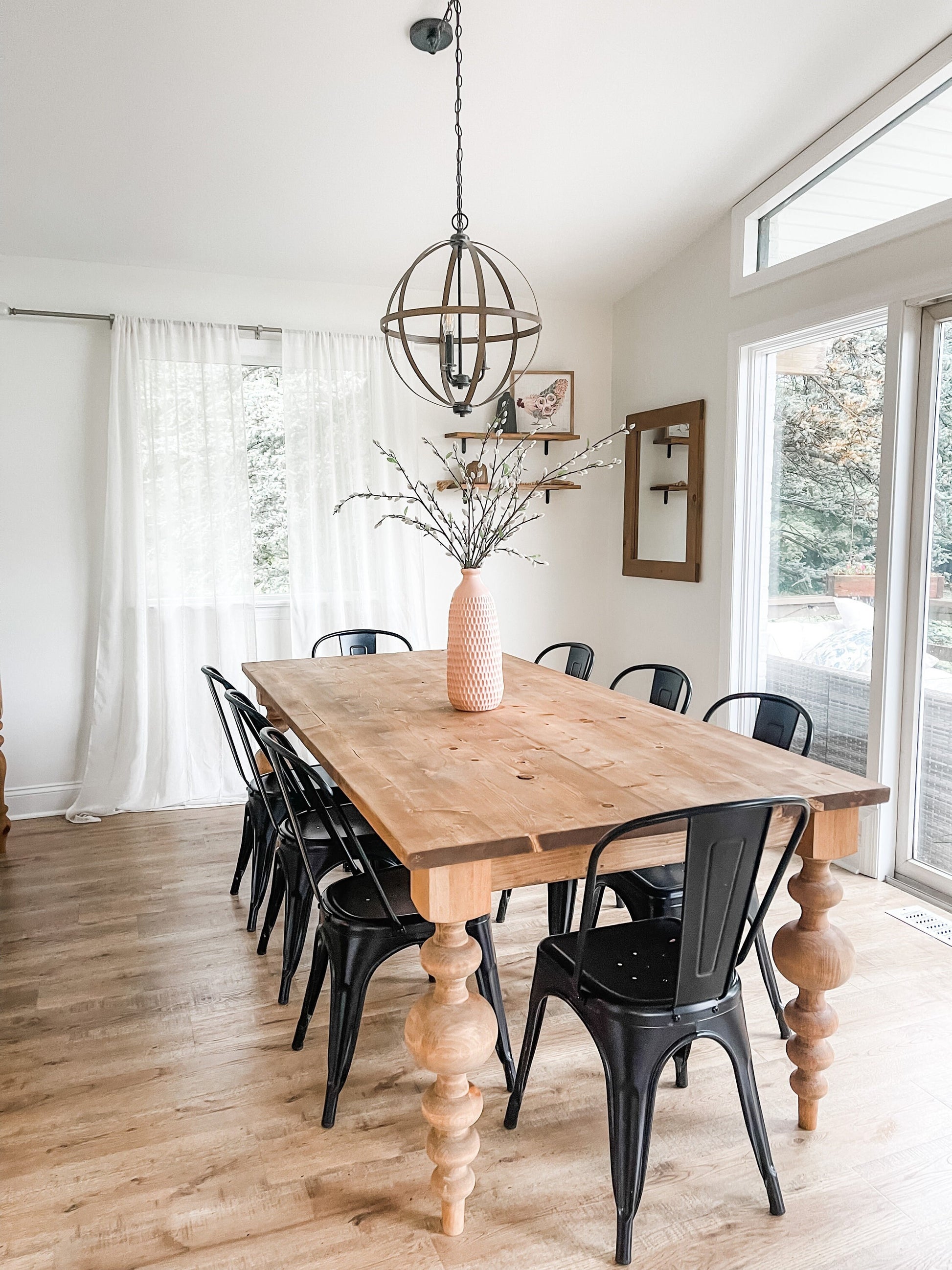From Typical to Modern: Discover the Ideal Eating Room Table Legs for Your Style
The choice of eating space table legs plays a critical role in defining the total character of your space, linking the space between typical craftsmanship and modern-day looks. While timeless styles such as cabriole and transformed legs evoke a feeling of ageless refinement, modern styles like barrette and geometric options present a possibility for striking aesthetic rate of interest. Evaluating the appropriate balance in between these styles requires a nuanced understanding of your existing design and individual preference. As you think about these elements, the inquiry stays: how can you flawlessly integrate these diverse leg designs to create an unified eating experience?
Understanding Table Leg Styles
The selection of dining-room table leg styles can significantly influence both the visual appeals and capability of the room. Each leg design contributes distinct sensible features and visual aspects, accommodating diverse layout preferences and use requirements. Comprehending these styles is crucial for choosing the ideal table that lines up with your overall interior decoration vision.
For circumstances, conical legs provide a clean, timeless appearance that can improve a room's style, while stand bases provide security and make the most of legroom, making them ideal for smaller sized rooms. Hairpin legs, a characteristic of mid-century modern-day layout, introduce an industrial flair, permitting a ventilated, open feel. Trestle legs evoke rustic beauty, supplying robust assistance and a sense of eternity.
In addition, the option of products plays a substantial duty. Wood legs can bring warmth and structure, whereas steel alternatives typically convey a streamlined, contemporary ambiance. Eventually, recognizing table leg designs is necessary for producing a natural dining location that reflects individual design while guaranteeing usefulness and convenience. By attentively thinking about these aspects, you can enhance both the useful and aesthetic appeal of your eating room.
Standard Table Leg Options
When picking dining-room table legs, traditional options often personify classic sophistication and workmanship. These layouts mirror a rich heritage and a dedication to high quality, making them excellent for those who value timeless aesthetic appeals.
One of the most legendary typical leg styles is the cabriole leg, defined by its elegant bent shape. This design typically includes attractive makings and is most commonly discovered in Queen Anne and Chippendale furniture. Another preferred alternative is the transformed leg, which flaunts a collection of smooth, rounded forms that give a timeless appearance while maintaining security.
In addition, the straight leg, while simple, provides a durable and basic framework that can blend perfectly with a range of tabletop styles. For those drawn to ornate describing, claw-and-ball feet legs stimulate a sense of grandeur and can work as a sensational focal point in any eating room.
Last but not least, stand bases, although not strictly legs, give a different typical alternative that enables ample legroom and can be beautifully sculpted. Each of these standard leg styles adds to the general setting of a dining area, marrying feature with aesthetic allure.

Modern Table Leg Designs
Modern table leg layouts use a diverse variety of styles that stress tidy lines and cutting-edge materials. These designs commonly prioritize performance while functioning as check here striking prime focus within a dining room. Minimalist visual appeals prevail, with legs crafted from materials such as steel, glass, and engineered wood, which add to a contemporary and ventilated feel.
One prominent layout is the hairpin leg, defined by its slender, conical framework that provides stability without overwhelming the tabletop (dining room table legs). This design is commonly located in mid-century modern furnishings and can effortlessly enhance various table forms. An additional fad is the usage of geometric shapes, where legs may handle asymmetrical or angular kinds, adding visual passion and a touch of artistry

Mixing Styles for One-of-a-kind Rooms
Typically, property owners seek to create one-of-a-kind eating areas that mirror their individual design by blending various style elements. This method allows for the incorporation of varied aesthetics, causing a harmonious yet distinctive setting. For instance, pairing a rustic wooden table with smooth, contemporary metal legs see page can develop a captivating contrast that boosts the space's general allure.
Furthermore, integrating vintage table legs with modern tabletops can stimulate a sense of background while maintaining a modern-day perceptiveness. Such combinations not just showcase individual taste however also encourage creativity, enabling property owners to curate a room that really feels both personal and welcoming.
Shade plays a crucial duty in this mixing process; selecting table legs that match or contrast with the existing color design can improve aesthetic interest. Whitewashed legs can soften the boldness of a dark table surface, developing a balanced aesthetic.
Tips for Selecting the Right Legs
Picking the right table legs is vital for achieving both functionality and aesthetic charm in your eating room. Begin by thinking about the general style of your area. Traditional settings gain from legs that include elaborate makings or turned designs, while contemporary spaces might require streamlined, minimal designs.
Following, evaluate the height and security of the legs. dining room table legs. Basic table vary between 28 to 30 inches in elevation, so ensure the legs complement this measurement for comfort. Additionally, robust materials, such as wood or metal, can improve stability and durability
Assess the leg form as well-- options consist of directly, tapered, or stand designs. Straight legs use a timeless appearance, while tapered legs can add a touch of style. Pedestal bases provide ample check my site legroom and are perfect for smaller spaces.
Conclusion
In summary, picking the ideal eating space table legs requires mindful factor to consider of both modern and traditional styles. By harmonizing leg style, elevation, and product with the overall design, a cohesive and inviting ambience can be accomplished.
The selection of dining room table leg designs can dramatically influence both the aesthetic appeals and performance of the room. Ultimately, recognizing table leg styles is important for producing a natural dining area that mirrors individual design while guaranteeing functionality and comfort.One of the most famous traditional leg designs is the cabriole leg, defined by its stylish bent form. Straight legs offer a traditional appearance, while tapered legs can include a touch of sophistication.In recap, choosing the perfect eating space table legs calls for cautious factor to consider of both contemporary and typical styles.
Comments on “Enhance Your Dining Room with Unique and Modern Dining Room Table Legs”